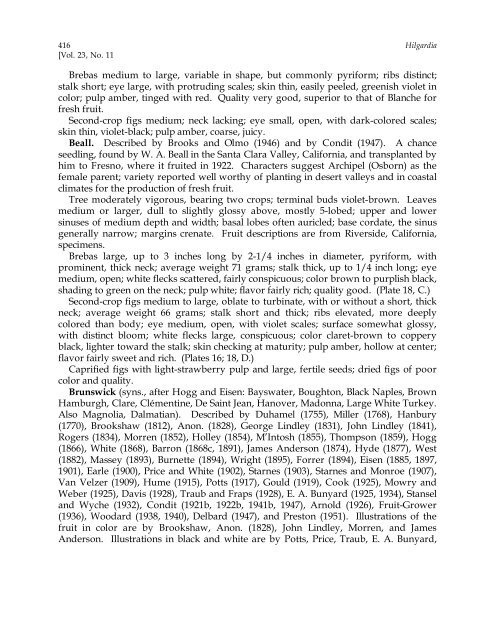Fig Varieties: A Monograph - uri=ucce.ucdavis
Fig Varieties: A Monograph - uri=ucce.ucdavis
Fig Varieties: A Monograph - uri=ucce.ucdavis
Create successful ePaper yourself
Turn your PDF publications into a flip-book with our unique Google optimized e-Paper software.
416 Hilgardia<br />
[Vol. 23, No. 11<br />
Brebas medium to large, variable in shape, but commonly pyriform; ribs distinct;<br />
stalk short; eye large, with protruding scales; skin thin, easily peeled, greenish violet in<br />
color; pulp amber, tinged with red. Quality very good, superior to that of Blanche for<br />
fresh fruit.<br />
Second-crop figs medium; neck lacking; eye small, open, with dark-colored scales;<br />
skin thin, violet-black; pulp amber, coarse, juicy.<br />
Beall. Described by Brooks and Olmo (1946) and by Condit (1947). A chance<br />
seedling, found by W. A. Beall in the Santa Clara Valley, California, and transplanted by<br />
him to Fresno, where it fruited in 1922. Characters suggest Archipel (Osborn) as the<br />
female parent; variety reported well worthy of planting in desert valleys and in coastal<br />
climates for the production of fresh fruit.<br />
Tree moderately vigorous, bearing two crops; terminal buds violet-brown. Leaves<br />
medium or larger, dull to slightly glossy above, mostly 5-lobed; upper and lower<br />
sinuses of medium depth and width; basal lobes often auricled; base cordate, the sinus<br />
generally narrow; margins crenate. Fruit descriptions are from Riverside, California,<br />
specimens.<br />
Brebas large, up to 3 inches long by 2-1/4 inches in diameter, pyriform, with<br />
prominent, thick neck; average weight 71 grams; stalk thick, up to 1/4 inch long; eye<br />
medium, open; white flecks scattered, fairly conspicuous; color brown to purplish black,<br />
shading to green on the neck; pulp white; flavor fairly rich; quality good. (Plate 18, C.)<br />
Second-crop figs medium to large, oblate to turbinate, with or without a short, thick<br />
neck; average weight 66 grams; stalk short and thick; ribs elevated, more deeply<br />
colored than body; eye medium, open, with violet scales; surface somewhat glossy,<br />
with distinct bloom; white flecks large, conspicuous; color claret-brown to coppery<br />
black, lighter toward the stalk; skin checking at maturity; pulp amber, hollow at center;<br />
flavor fairly sweet and rich. (Plates 16; 18, D.)<br />
Caprified figs with light-strawberry pulp and large, fertile seeds; dried figs of poor<br />
color and quality.<br />
Brunswick (syns., after Hogg and Eisen: Bayswater, Boughton, Black Naples, Brown<br />
Hamburgh, Clare, Clémentine, De Saint Jean, Hanover, Madonna, Large White Turkey.<br />
Also Magnolia, Dalmatian). Described by Duhamel (1755), Miller (1768), Hanbury<br />
(1770), Brookshaw (1812), Anon. (1828), George Lindley (1831), John Lindley (1841),<br />
Rogers (1834), Morren (1852), Holley (1854), M’Intosh (1855), Thompson (1859), Hogg<br />
(1866), White (1868), Barron (1868c, 1891), James Anderson (1874), Hyde (1877), West<br />
(1882), Massey (1893), Burnette (1894), Wright (1895), Forrer (1894), Eisen (1885, 1897,<br />
1901), Earle (1900), Price and White (1902), Starnes (1903), Starnes and Monroe (1907),<br />
Van Velzer (1909), Hume (1915), Potts (1917), Gould (1919), Cook (1925), Mowry and<br />
Weber (1925), Davis (1928), Traub and Fraps (1928), E. A. Bunyard (1925, 1934), Stansel<br />
and Wyche (1932), Condit (1921b, 1922b, 1941b, 1947), Arnold (1926), Fruit-Grower<br />
(1936), Woodard (1938, 1940), Delbard (1947), and Preston (1951). Illustrations of the<br />
fruit in color are by Brookshaw, Anon. (1828), John Lindley, Morren, and James<br />
Anderson. Illustrations in black and white are by Potts, Price, Traub, E. A. Bunyard,
















![Fig Trees in North Carolina [Archive] - IDigMyGarden ... - Figs 4 Fun](https://img.yumpu.com/26905320/1/190x245/fig-trees-in-north-carolina-archive-idigmygarden-figs-4-fun.jpg?quality=85)